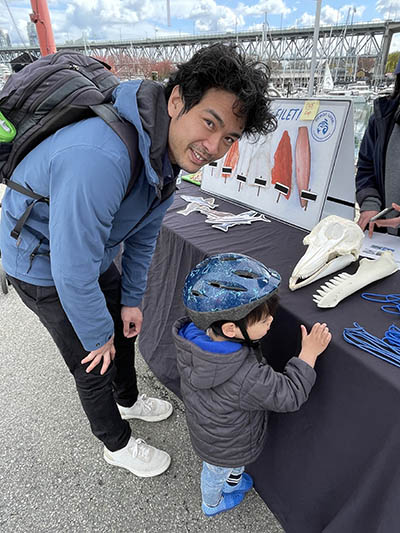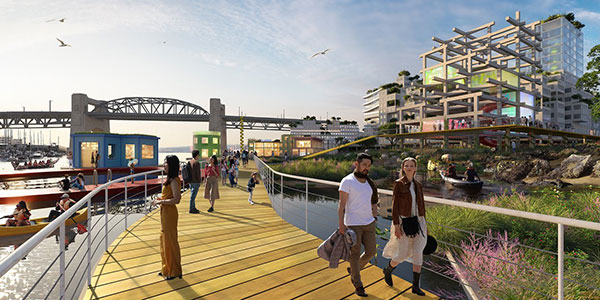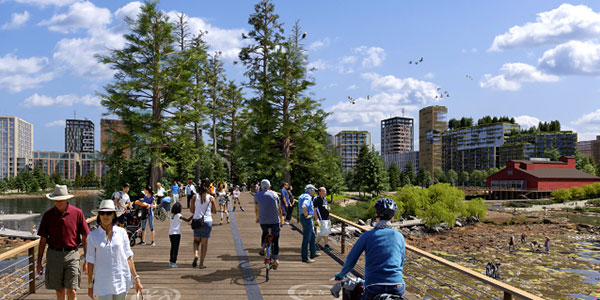About Vancouver
Embraced by water, including the Salish Sea to the west, Burrard Inlet to the north, and the north arm of the Fraser River to the south, we have always been a coastal community defined by our proximity to the ocean, river, and mountains.
Vancouver is situated on the unceded traditional homelands of xʷməθkʷəy̓əm (Musqueam), Skwxwú7mesh (Squamish), and səlilwətaɬ (Tsleil-Waututh). The area currently known as False Creek is of significant meaning to the local First Nations who stewarded the land since time immemorial.
We recognize the need to plan for future sea level rise and help flood-vulnerable shoreline neighbourhoods, communities, and businesses to become more resilient to current and future coastal flooding.
The Sea2City Design Challenge Video file (Sea2City) was a collaborative design challenge to rethink the future of the False Creek shoreline. The project brought together two multi-disciplinary design teams, City staff, local coastal adaptation experts and Host Nation representatives, knowledge keepers, and designers from Musqueam, Squamish, and Tsleil-Waututh over a 12-month period to reimagine key sites along Vancouver’s False Creek shoreline.
The teams showed how these sites can adapt to rising sea levels while accommodating urban development and fostering ecological revitalization. The work will also inform the next phase of our Climate Adaptation Plan and Coastal Adaptation Plan.
Guided by Host Nation values, community values, and design principles identified through earlier engagement, Sea2City provided a collective learning and capacity building opportunity for us, project partners, and design teams to:
- Increase public awareness of sea level rise and coastal flooding and opportunities to address it
- Explore and develop a coastal adaptation approach that centres reconciliation with Host Nations who have stewarded Vancouver’s coastline since time immemorial
- Investigate coastal adaptation approaches that respond to the social equity, economic, and ecological challenges posed by sea level rise and coastal flooding
- Examine options for sea level rise of at least two metres
Outcomes
Sea2City was designed as a deeply collaborative initiative to demonstrate a more decolonized planning approach to the shoreline.
Outcomes from the Sea2City Design Challenge include:
- Increased capacity and understanding about the people who work, live and play in False Creek, decolonizing coastal adaptation planning, and the impacts of coastal flooding
- A range of exciting and pragmatic design concepts that respond to the challenges posed by sea level rise and coastal flooding
- Decolonized language, coastal adaptation design principles, and design concepts that test 2 metres of sea level rise
- Connecting with over 2,000 community members, advisory group members, collaborators, students and members of the public directly, and 160,000 people across social media platforms
Conceptual designs, created as part of Sea2City, will:
- Not be built immediately
- Inform next steps (including more detailed design development and planning)
We will start to take those next steps after the completion of Sea2City, and it will likely continue for several years recognizing the additional research, planning, technical design, and engagement that will be required.
Documents
Final reports
- View a video about the Sea2City Design Challenge Video file
- A long-term Vision for False Creek PDF file (3.6 MB) - False Creek is vulnerable to sea level rise and coastal flooding
- The Sea2City Design Challenge Project Story PDF file (11 MB), a summary for elected officials and members of the public by EcoPlan International and us
- The Sea2City Design Challenge Report PDF file (18 MB), a longer form report for policy makers and researchers by EcoPlan International and us
- Sea2City Design Challenge South False Creek Coastal Adaptation Design Report PDF file (7 MB) by Mithun + One Architecture + Modern Formline + Herrera + Moffatt & Nichol
- Sea2City Design Challenge North Creek Collective Design, Planning, and Costing Brief PDF file (15 MB) by PWL Partnership + MVRDV + Modern Formline + Deltares
- Sea2City Design Challenge Design Concept Summaries PDF file (35 MB)
- Sea2City Youth Adaptation Lab Program Summary PDF file (5 MB) by CityHive and us
- Youth Manifesto PDF file (100 KB) by the Youth Adaptation Lab
Supporting documents
- Sea2City primer PDF file (10 MB) on values-based planning and evaluation
- Rise to the Challenge: Sea2City Design Challenge Roadmap PDF file (14 MB)
The future of the False Creek shoreline
Learn more about sea level rise
Get more information on sea level rise in False Creek and what we have begun to prepare for it: Review Coastal Adaptation False Creek
Contact us
Email: [email protected]




